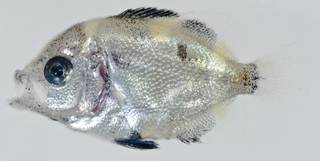WoRMS taxon details
Pomacanthidae Jordan & Evermann, 1898
- Genus Apolemichthys Burton, 1934
- Genus Centropyge Kaup, 1860
- Genus Chaetodontoplus Bleeker, 1876
- Genus Genicanthus Swainson, 1839
- Genus Holacanthus Lacepède, 1802
- Genus Paracentropyge Burgess, 1991
- Genus Pomacanthus Lacepède, 1802
- Genus Pygoplites Fraser-Brunner, 1933
- Genus Acanthochaetodon Bleeker, 1876 accepted as Holacanthus Lacepède, 1802
- Genus Angelichthys Jordan & Evermann, 1896 accepted as Holacanthus Lacepède, 1802
- Genus Arusetta Fraser-Brunner, 1933 accepted as Pomacanthus Lacepède, 1802 (synonym)
- Genus Centriopyge accepted as Centropyge Kaup, 1860 (unaccepted > misspelling - incorrect subsequent spelling)
- Genus Centropyges accepted as Centropyge Kaup, 1860 (misspelling)
- Genus Chetodon accepted as Chaetodon Linnaeus, 1758 (misspelling)
- Genus Desmoholacanthus Fowler, 1941 accepted as Apolemichthys Burton, 1934
- Genus Euxiphipops Fraser-Brunner, 1934 accepted as Pomacanthus Lacepède, 1802
- Genus Holocanthus Gronow, 1854 accepted as Sphoeroides Anonymous [Lacepède], 1798
- Genus Pomacanthodes Gill, 1862 accepted as Holacanthus Lacepède, 1802 (synonym)
- Genus Pomacanthops Smith, 1955 accepted as Pomacanthus Lacepède, 1802 (synonym)
- Genus Sumireyakko Burgess, 1991 accepted as Centropyge Kaup, 1860
- Genus Xiphipops Jordan, 1922 accepted as Centropyge Kaup, 1860 (synonym)
marine, brackish, terrestrial
Not documented
Description Tropical Atlantic, Indian, and (mainly western) Pacific. Strongly compressed body. Angle of preopercle with a strong spine....
Description Tropical Atlantic, Indian, and (mainly western) Pacific. Strongly compressed body. Angle of preopercle with a strong spine. Three spines in anal fin. Many species have an elongate extension on hind margin of soft dorsal and anal fins. Caudal fin rounded to strongly lunate with 15 branched rays. Vertebrae 24 (10+14). Striking coloration, markedly different between juveniles and adults of many species. In shallow waters of less than 20 m deep, very seldom below 50 m; generally near coral reefs. All species studied to date are protogynous hermaphrodites with 'haremic' social system. Species of Centropyge feed primarily on filamentous algae and species of Genicanthus feed primarily on zooplankton; most others feed on sponges, invertebrates, algae and fish eggs. Poma- = operculum, acanth- (gr.) = spine [details]
Froese, R. and D. Pauly. Editors. (2025). FishBase. Pomacanthidae Jordan & Evermann, 1898. Accessed through: World Register of Marine Species at: https://www.marinespecies.org/aphia.php?p=taxdetails&id=151470 on 2025-12-14
Date
action
by
![]() The webpage text is licensed under a Creative Commons
Attribution 4.0 License
The webpage text is licensed under a Creative Commons
Attribution 4.0 License
Nomenclature
basis of record
Fricke, R., Eschmeyer, W. N. & Van der Laan, R. (eds). (2025). ECoF. Eschmeyer's Catalog of Fishes: Genera, Species, References. <em>California Academy of Sciences. San Francisco.</em> Electronic version accessed dd mmm 2025., available online at http://researcharchive.calacademy.org/research/Ichthyology/catalog/fishcatmain.asp [details]
Taxonomy
taxonomy source
Van Der Laan, R.; Eschmeyer, W. N.; Fricke, R. (2014). Family-group names of Recent fishes. <em>Zootaxa.</em> 3882(1): 1-230., available online at https://doi.org/10.11646/zootaxa.3882.1.1 [details] Available for editors  [request]
[request]
Other
context source (PeRMS)
Chirichigno, N.; Cornejo, M. (2001). Catálogo comentado de los peces marinos del Perú. <em>2ª ed. Instituto del Mar de Perú. Publicación Especial. Callao.</em> 314 p. [details]
 Present
Present  Inaccurate
Inaccurate  Introduced: alien
Introduced: alien  Containing type locality
Containing type locality
Unreviewed
Description Tropical Atlantic, Indian, and (mainly western) Pacific. Strongly compressed body. Angle of preopercle with a strong spine. Three spines in anal fin. Many species have an elongate extension on hind margin of soft dorsal and anal fins. Caudal fin rounded to strongly lunate with 15 branched rays. Vertebrae 24 (10+14). Striking coloration, markedly different between juveniles and adults of many species. In shallow waters of less than 20 m deep, very seldom below 50 m; generally near coral reefs. All species studied to date are protogynous hermaphrodites with 'haremic' social system. Species of Centropyge feed primarily on filamentous algae and species of Genicanthus feed primarily on zooplankton; most others feed on sponges, invertebrates, algae and fish eggs. Poma- = operculum, acanth- (gr.) = spine [details]


